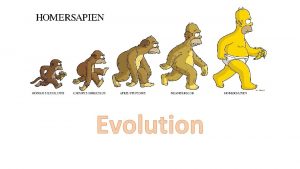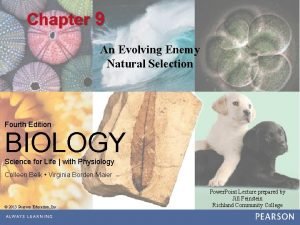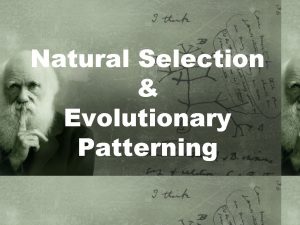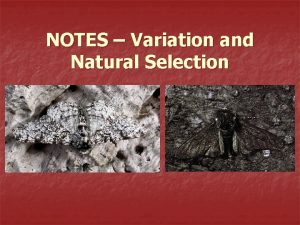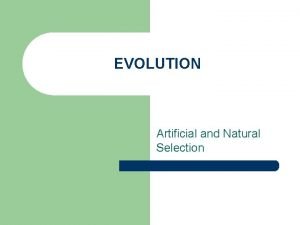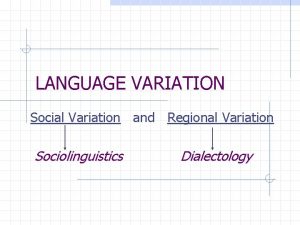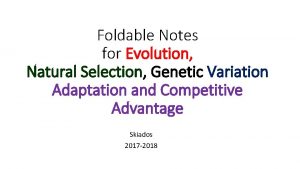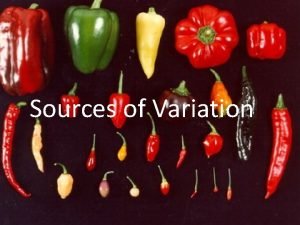NOTES 29 Variation and Natural Selection Are individuals
















- Slides: 16

NOTES 29 – Variation and Natural Selection

Are individuals in a population of a species the same? n n No – all members of a species share the common characteristics of that species, but there are still differences Variation – differences between individuals of the same species n EX. All dogs have hair, but not all dogs have the same color hair

Dog Variation

What causes variation? There are 2 main causes of variations in a population: 1. Mutation – A change in the DNA of an organism that leads to a change in a protein being made by the organism n n Sometimes the new protein can lead to a new trait Mutations can be caused by DNA being copied incorrectly during replication, by mistakes during meiosis, or by radiation or chemicals in the environment

What causes variation? There are 2 main causes of variations in a population: n Recombination – The creation of a new set of DNA in offspring during sexual reproduction n Since each parent passes down only ½ of their DNA, the DNA in the offspring is a unique combination of DNA from both parents

How does variation lead to evolution? n n Sometimes mutations or recombination results in a trait that improves an organism’s chances for survival Adaptation – a trait that helps an organism to survive n There are 2 types of adaptations: 1. Structural Adaptation 2. Behavioral Adaptation

How does variation lead to evolution? 1. Structural Adaptation – a physical trait that helps an organism to survive (EX. the sharp teeth of a lion, the spines of a cactus)

How does variation lead to evolution? 2. Behavioral Adaptation – a behavioral trait that helps an organism to survive (EX. plover birds faking injury to lure predators away from nest)

How does variation lead to evolution? n n n Adaptations are traits which means they are caused by genes Organisms with the best adaptations have the best genes These organisms survive and reproduce more, passing on their genes, and changing the gene pool of the species in the next generation

How does variation lead to evolution? n n As the gene pool changes generation after generation, the species characteristics change or evolve After enough time goes by, the species can undergo major changes

What is natural selection? n In 1859, Charles Darwin published his book On the Origin of Species, where he explained how species evolve by a process called natural selection

What is natural selection? n n Natural Selection – process where organisms with the best adaptations for their environment survive, reproduce, and pass their genes to the next generation Natural selection is a 4 -step process: 1. Overproduction – there are more organisms born than the environment can support 2. Competition – organisms compete with other members of the population for resources (food, shelter, water, mates)

What is natural selection? 3. Survival of the Fittest – organisms in a population are not all the same (variation) organisms with the best adaptations are more successful than organisms without these adaptations so they live longer and reproduce more 4. Passing of Traits – genes that cause adaptations are passed from one generation to the next, changing the gene pool and causing changes in the overall traits of the species

EX. Giraffes 1. More giraffes are born than the environment can support 2. Giraffes compete for resources 3. The giraffes with the longest necks have a survival advantage, so they survive longer and reproduce more

EX. Giraffes 4. The genes causing the longest necks are passed on more than the other neck genes, changing the giraffe gene pool and causing the average neck length of giraffes to increase from one generation to the next

Remember… n n n Individuals DO NOT EVOLVE Species Evolve when traits are passed from one generation to the next in an unequal way, which makes some traits appear more than others in the next generation Over many generations, this can lead to large changes in the overall traits of a species population
 Mikael ferm
Mikael ferm Evolution
Evolution Artificial selection vs natural selection
Artificial selection vs natural selection Natural selection vs artificial selection
Natural selection vs artificial selection Artificial selection vs natural selection
Artificial selection vs natural selection Example of stabilizing selection
Example of stabilizing selection Natural selection vs artificial selection
Natural selection vs artificial selection Which graph represents a function with direct variation
Which graph represents a function with direct variation Direct and inverse graphs
Direct and inverse graphs Correlation and regression
Correlation and regression Natural variation and fundamental divergence in handwriting
Natural variation and fundamental divergence in handwriting Direct variation notes
Direct variation notes Notesdirect
Notesdirect Two way selection and multiway selection
Two way selection and multiway selection Multiway selection
Multiway selection Mass selection and pure line selection
Mass selection and pure line selection Natural selection and drug resistance
Natural selection and drug resistance

